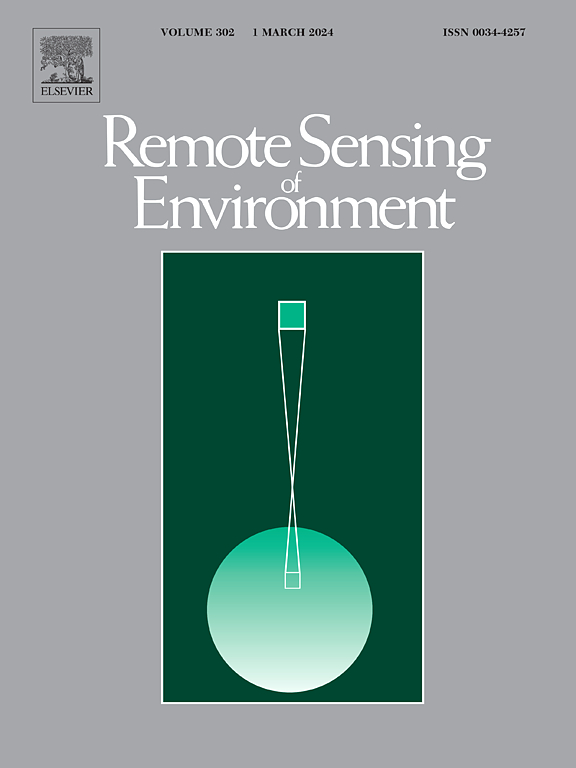Modeling 3D radiative transfer for maize traits retrieval: A growth stage-dependent study on hyperspectral sensitivity to field geometry, soil moisture, and leaf biochemistry
IF 11.1
1区 地球科学
Q1 ENVIRONMENTAL SCIENCES
引用次数: 0
Abstract
This study integrates a dynamic plant growth model with a three-dimensional (3D) radiative transfer model (RTM) for maize traits retrieval using high spatial–spectral resolution airborne data. The research combines the Discrete Anisotropic Radiative Transfer (DART) model with the Dynamic L-System-based Architectural maize (DLAmaize) growth model to simulate field reflectance. Comparison with the 1D RTM SAIL revealed limitations in representing row structure effects, field slope, and complex light–canopy interactions. Novel Global Sensitivity Analyses (GSA) were carried out using dependence-based methods to overcome limitations of traditional variance-based approaches, enabling better characterization of hyperspectral sensitivity to changes in leaf biochemistry, canopy architecture, and soil moisture. GSA provided complementary results to assess estimation uncertainties of the proposed traits retrieval method across growth stages. A hybrid inversion framework combining DART simulations with an active learning strategy using Kernel Ridge Regression was implemented for traits estimation. The approach was validated using ground data and HyPlant-DUAL airborne hyperspectral images from two field campaigns in 2018 and achieved high retrieval accuracy of key maize traits: leaf area index (LAI, R2=0.91, RMSE=0.42 m2/m2), leaf chlorophyll content (LCC, R2=0.61, RMSE=3.89 g/cm2), leaf nitrogen content (LNC, R2=0.86, RMSE=1.13 × 10−2 mg/cm2), leaf dry matter content (LMA, R2=0.84, RMSE=0.15 mg/cm2), and leaf water content (LWC, R2=0.78, RMSE=0.88 mg/cm2). The validated models were used to generate two-date 10 m resolution maps, showing good spatial consistency and traits dynamics. The findings demonstrate that integrating 3D RTMs with dynamic growth models is suited for maize trait mapping from hyperspectral data in varying growing conditions.
玉米性状检索的三维辐射转移建模:对田间几何形状、土壤湿度和叶片生物化学的高光谱敏感性的生长阶段依赖性研究
本研究将植物动态生长模型与三维辐射传输模型(RTM)相结合,利用高空间光谱分辨率航空数据检索玉米性状。该研究将离散各向异性辐射传输(DART)模型与基于动态l系统的建筑玉米(DLAmaize)生长模型相结合,模拟了场地反射率。与1D RTM SAIL相比,SAIL在表示行结构效应、场斜率和复杂的光冠相互作用方面存在局限性。利用基于依赖的方法,克服了传统基于方差的方法的局限性,实现了对叶片生物化学、冠层结构和土壤湿度变化的高光谱敏感性的更好表征。GSA提供了互补的结果来评估所提出的性状检索方法在不同生长阶段的估计不确定性。基于核岭回归,实现了DART模拟与主动学习策略相结合的混合反演框架。利用2018年两次野外试验的地面数据和HyPlant-DUAL机载高光谱影像对该方法进行了验证,获得了较高的玉米关键性状检索精度:叶面积指数(LAI, R2=0.91, RMSE=0.42 m2/m2)、叶片叶绿素含量(LCC, R2=0.61, RMSE=3.89 μg/cm2)、叶片氮含量(LNC, R2=0.86, RMSE=1.13 × 10−2 mg/cm2)、叶片干物质含量(LMA, R2=0.84, RMSE=0.15 mg/cm2)和叶片含水量(LWC, R2=0.78, RMSE=0.88 mg/cm2)。验证后的模型用于生成两日期10 m分辨率的地图,显示出良好的空间一致性和特征动态。研究结果表明,将三维rtm与动态生长模型相结合适用于不同生长条件下高光谱数据的玉米性状定位。
本文章由计算机程序翻译,如有差异,请以英文原文为准。
求助全文
约1分钟内获得全文
求助全文
来源期刊

Remote Sensing of Environment
环境科学-成像科学与照相技术
CiteScore
25.10
自引率
8.90%
发文量
455
审稿时长
53 days
期刊介绍:
Remote Sensing of Environment (RSE) serves the Earth observation community by disseminating results on the theory, science, applications, and technology that contribute to advancing the field of remote sensing. With a thoroughly interdisciplinary approach, RSE encompasses terrestrial, oceanic, and atmospheric sensing.
The journal emphasizes biophysical and quantitative approaches to remote sensing at local to global scales, covering a diverse range of applications and techniques.
RSE serves as a vital platform for the exchange of knowledge and advancements in the dynamic field of remote sensing.
 求助内容:
求助内容: 应助结果提醒方式:
应助结果提醒方式:


